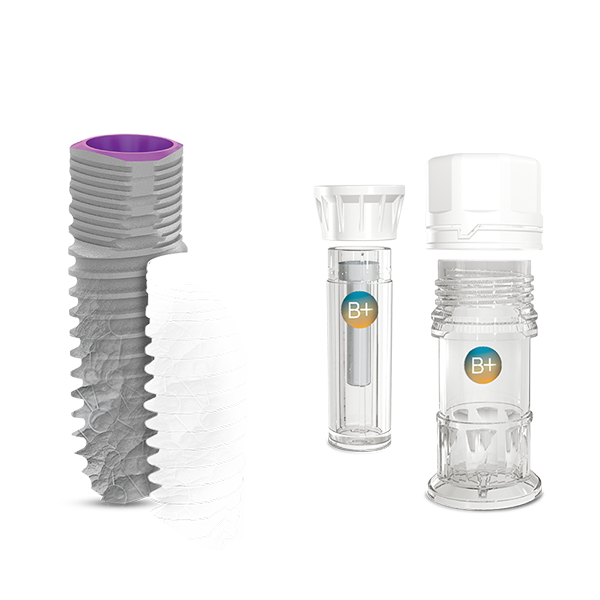B for Biology
B+ is a mono molecular layer of multi-phosphonates. It is permanently bound to the surface of the implant and is perceived as bone-like by the body.
The technology has been clinically demonstrated to result in visible bone growth directly on the surface of the B+ implant in sheep. The characteristics of B+ promote enhanced clinical performance and better preservation of bone levels around the implant as observed in a study with sheep. This may potentially lead to longer term implant survival, even in patients with compromised bone healing situations.
Molecules of B+ chemically bind to the implant surface, creating a hydrophilic surface and remain stable throughout the life span of the implant. The phosphonated molecules of B+ have demonstrated high stability in terms of chemical degradation. These properties prevent the molecules from detaching from the implant surface, which allows them to remain present for the lifespan of the implant.
This novel, phosphonate rich surface is designed to mimic one of the main constituents of bone, which may provide more favorable environment for implant integration. It has also been observed to accelerate the healing process, eliminate the “micro gap” between the bone and implant surface, and increase the fixation of the implant in bone.
Benefits
- Hydrophilicity: Current literature demonstrates a linkage between improved bone healing and early osseointegration with the hydrophilicity of surface. MIS implant surface treatment combines sand-blasting and acid-etching. These treatment types increase the potential for surface purity and hydrophilic properties. B+ enhances the wettability of the implant surface, and this may attract water, proteins, and cells from the blood, and possibly enable quicker cell adhesion and colonization, which may result in faster bone matrix formation and osseointegration.
- Biomechanical Fixation: Once on the implant surface, a new bone matrix may be formed quickly, maturing to organized mineralized bone. The biomimetic characteristics of B+ may allow for greater implant integration at earlier stages, which may lead to long-term optimal osseointegration. The increased number of bone cells in contact with the B+ implant may result in enhanced biomechanical implant fixation very early on in the healing process. Increased fixation with B+ has been observed to reduce healing time.
- Elimination of the “Micro-Gap”: In addition to possible mechanical interlocking resulting from the implant’s roughened topography, B+ may also provides a chemical connection between bone and implant surface, eliminating the “micro-gap”. This may result in early functional implant stability and fixation.
- Stability in a Physiological Environment: The B+ molecule was shown to remain permanently bound to the implant surface throughout osseointegration. Furthermore, unlike phosphates, phosphonated molecules such as B+ are chemically stable, ensuring that B+ will remain attached to the implant and will not be released into the body over time.
Technical Information
- Hydrophilic
- Biomimetic
- Enhanced biomechanical implant fixation
- Stable and biocompatible

